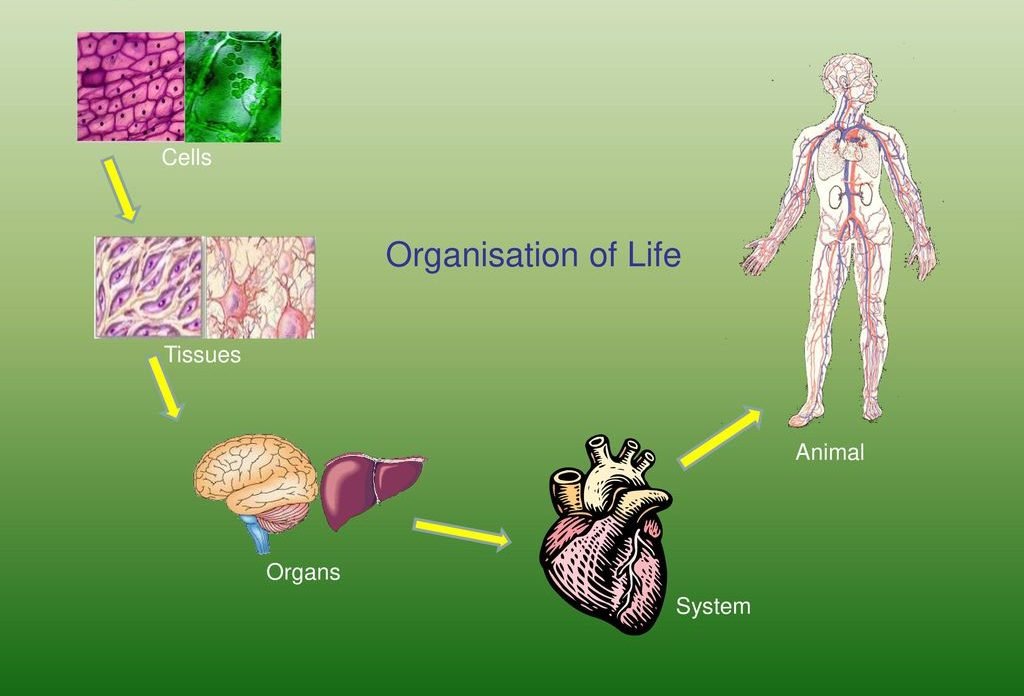Back to: BIOLOGY SS1
Welcome to class!
In today’s class, we will be talking about the organisation of life. Enjoy the class!
Organisation of Life

Levels of organization of life
All living things are highly organised. And the organisation occur in levels. Every living thing is made up of a cell or a number of cells. A single-celled organism is called unicellular while a many-celled organism is called multicellular. Organization of life is, therefore, the existence of life from a single-celled organism to a multicellular organism with complex forms that perform different functions. Four levels of organization of life exist, namely: cell, tissue, organ and system.
- Cell: A cell is a functional and structural unit of protoplasm bounded by a membrane and containing nuclear and cytoplasmic materials. Some living things exist as cells which have cytoplasmic structures such as pseudopodia, cilia, flagella and vacuoles. These cytoplasmic structures are called organelles. They are subunits of a cell. Examples of organisms at the cell level are Amoeba, Chlamydomonas, Paramecium and Euglena. Common cells that perform distinct functions in plant and animals include sperm cells, nerve cells, bone cells, red blood cells, root hair cells etc.
- Tissues: A tissue is a collection of cells which are similar in structure and functions. Hydra is an example of an animal that is made up of tissues only. Examples of tissues in animals and plants are epithelial tissue, blood, nerve tissue, muscle tissue, xylem and phloem tissues etc.
- Organ: An organ is a collection of different tissues that perform a common function or functions e.g. Kidney, heart, brain, stem, roots etc. Example of the organ in a plant is onion bulb. Platyhelminthes are examples of whole organisms at the organ level of organisation.
- System: A system is a set of organs which co-operate to carry out one of the vital functions of life e. g. Digestive system, respiratory system, reproductive system, transport system etc.
The complexity of organization in higher organisms
Higher organisms have bodies that are differentiated into specialised parts performing different functions. The different specialized parts made up of tissues, organs and systems make higher organisms more complex and efficient to carry out various activities of life.
There is an increase in Complexity from Unicellular organism to Multicellular organism. This increase in complexity is in Structure, Function, Activity, Behaviour and Mode of Life. Unicellular organisms carry-out all the living processes in one cell.
Advantages of complexity in higher organisms
- It leads to the division of labour and specialization
- It has led to the efficiency of the various organs of the body.
- The complexity of higher organisms has led to their survival (adaptation) in their different habitats.
- They can perform complicated physiological functions. Eg. Faster movement enhances efficiency and therefore adaptability to their environment.
- Ability to capture smaller organisms for food.
- They can adapt to harsh conditions
- Ability to conserve energy due to complex organs that can save energy.
- Efficient transport of substances in the body. For eg, the circulatory system can transport blood in the body without interfering with other systems.
- Division of level helps the body to live longer.
- Death of a cell or cells cannot stop the function of the organ because of the large number of cells that perform a particular function.
- It gives room for wound healing.
- Lesson number of times the organisms fall sick due to large functional reserves.
Disadvantages of complexity
- Individual cells are not capable of existing independently and therefore depend on one another’s activities to exist
- With complexity, the ability to regenerate lost parts decreases.
- Difficulties in the acquisition of food materials and oxygen and loss of waste product
- Difficulties in reproduction
- It leads to a slower rate of diffusion because the surface area to volume ratio is small and the distance from the exterior to the centre of the body is great
- All plants must be kept functioning together in a coordinated manner.
- Complexity gives rise to a bigger size of a higher organism which in turn lead to a requirement of more space, energy and environmental resources than single-cell organisms.
- There is increase metabolic rate which consumes more food.
- It creates room for competition for survival.
- complex organisms take more time to reproduce the younger ones.
- The more complex an organism, the more difficult it is to determine the cause of disease.
In our next class, we will be talking about Plant Nutrition. We hope you enjoyed the class.
Should you have any further question, feel free to ask in the comment section below and trust us to respond as soon as possible.

What are the exam of unicellular organisms
I LOVE THIS CLASS. OOOOOOOOOH!!!
l love it
Can i get a question under this topics
I love this class…it teaches allot of things
I also love this app
even me
thanks i appricate
Glad you found it helpful😊 For even more class notes, engaging videos, homework assistance, just download our Mobile App at https://play.google.com/store/apps/details?id=com.afrilearn. It’s packed with resources to help you succeed🌟
thanks
i love this topic and i use it every day to do some of my inlongstration.
Wow These class is fun
I love this app
Classnotes well done
wow I love this
great class
nice 😊🤭👍
thank
Can questions be giving after each class
I love this app very well oooooh
I also to
even me
Thanks